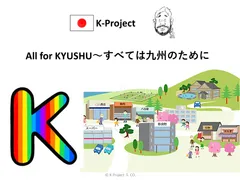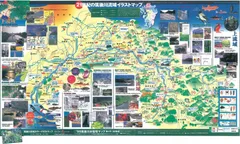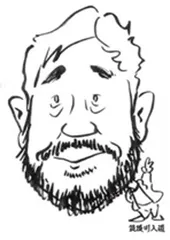First Phase of Kyushu Creation Project "K Project" Launched Launched "K Money," a regional common point system aimed at regional revitalization in the Chikugo River Basin
No need for merchants to spend time and money on POS register modifications, etc. There are no initial costs, such as franchise fees!
株式会社福報メディアエージェンシー
Fukuho Media Agency, Inc. (Higashi Ward, Fukuoka City; CEO: Hideo Nishimoto) will launch "K-Money," a regional common point of sale in the Chikugo River basin, as the first phase of the "K Project," a Kyushu creation project conceived by Kurume University Professor Emeritus Tadashi Dadai. The project is scheduled to be launched on April 1, 2024.
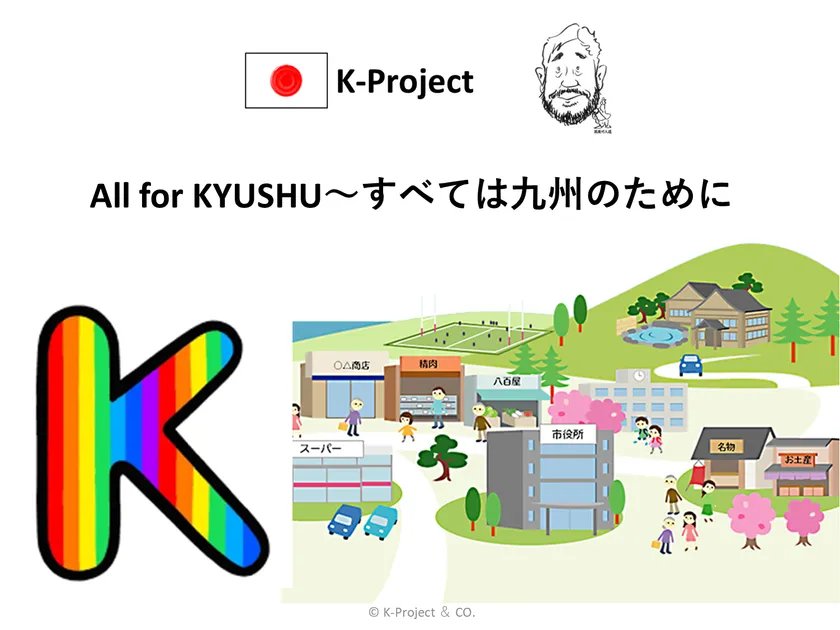
All for KYUSHU ~All for KYUSHU
Users simply download the dedicated smartphone application "K-appli" and present the application screen to receive "K-money" points for everyday purchases and other consumption activities at member merchants, while member merchants will be able to give and receive points by downloading the corresponding application dedicated for member merchants to their tablet terminals. Member merchants can use the points by downloading the corresponding application for the merchant store to their tablet terminals. The main system is provided by Blue Alliance K.K. (Minato-ku, Tokyo; CEO: Kazuya Kawano). There are no initial costs such as franchise fees, and businesses in the Chikugo River basin can join free of charge as long as they have a tablet terminal. The first 45 "Michi-no-Eki" and "Kawan-no-Eki" stations in the Chikugo River Basin are expected to become member businesses, with an estimated 100,000 registered users in the first year. The second and subsequent member businesses will be updated as needed.
List of K-money member stores (tentative)
Roadside Stations and River Stations (Total: 45 locations)
Choshabaru Visitor Center / Kokonoe Dream Suspension Bridge Product Direct Sales Tenkuma / Michi no Eki Kokonoe Furusato Kan / Michi no Eki Doen no Sato Kusu / Michi no Eki Jien no Taki Kusu / Amanokuni Plaza / Husband and Wife Falls, Taki no Souvenir Shop / Minami Oguni Town General Products Kiyora Kaasa / Michi no Eki "Oguni" Yu Station / Oguni Service Area Windmill / Shimeokenkan / Matsu Barakan / Osusowake Vegetable Restaurant Matsubara / Mizube-no-Sato Oyama / Kaorucho Sake Museum / Kameyama-tei Hotel / Yamano Soba Teahouse / Roadside Station Taio Kinzan / Fureai Hiroba Tsuzumi no Sato / Roadside Station Oishiwara / Roadside Station Ukiha / Roadside Station Harazuru Farm Station Basaro / Triple Water Mill Village Asakura / Amagi Water Culture Village / Tourism Plaza Hotomekikan Michi no Mekkan / Roadside Station Chikuzen Minaminosato / Kanko Kaikan Dozo / Nijinominosato / Homeya / Chikugo River Station Shibakari / Oyado Nakamura / Grocery Store Cafe Nootooto (No. 2) / Roadside Station Kurume / Chikugo River Disaster Prevention Facility Kurume-us / Passion Blossoming Kurume Bogen no Mori / Torigoe Onsen Seiriki Museum / Ryotei Ryokan Mikawaya Okawa TERRAZZA / Bridge Station Dorompa / Roadside Station Oki / Daito Enterprises / Yanagawa Yokamonkan / River Station Funakoya Koihotaru / Yame Doll Hall
What is a "river station"?
The "River Stations" are roadside stations and tourism-related facilities located near rivers. The above registered "River Stations" conduct stamp rallies to promote interaction and activities among people.
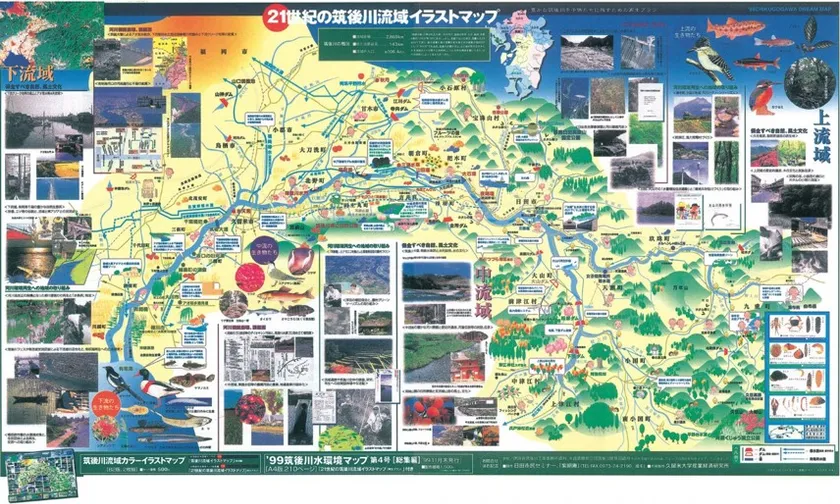
The "river station" is a roadside station or sightseeing facility located near a river.
What is the Chikugo River?
The Chikugo River originates in the Senomoto Plateau in Aso County, Kumamoto Prefecture, flows through steep mountainous areas, and flows through a typical mountain basin in Hita City, where it joins the Oyama River and the Kuju River flowing down from the Kuju Mountain Range. It eventually passes the Yamei Gorge and flows through the fertile Tsukushi Plain with many tributary rivers such as the Sada River, Koishiwara River, Geise River, and Houman River, before diverting the Hayatsue River and emptying into the Ariake Sea. The Chikugo River is the largest first-class river in Kyushu, flowing through the four prefectures of Kumamoto, Oita, Fukuoka, and Saga, with a channel length of 143 km and a basin area of 2,860 square kilometers.
The Chikugo River watershed spans the four prefectures of Kumamoto, Oita, Fukuoka, and Saga, with major cities such as Hita City in the upper reaches, Kurume City and Tosu City in the middle reaches, and Okawa City and Saga City in the lower reaches, and the current population in the watershed is approximately 1.1 million.
About the K Project
The K Project fully supports the "Professor Emeritus Dadais' Local Currency Concept" as a scheme to revitalize the economy of the Chikugo River watershed, which forms the basis of social, economic, and cultural activities in northern Kyushu and has long had deep ties with people's lives and culture, in the form of "local production for local consumption". In order to realize and complete this concept, we have commercialized "K-money," a common local point system, as the first phase of the project plan, which will help "local production for local consumption" of the economy. Furthermore, this application is scheduled to be upgraded in the future to include the following functions: communication functions such as community-based latest information and deals to disaster information and evacuation information to make the daily lives of local residents richer and happier, convenience functions such as daily shopping services and cab dispatch, and real-time help services to protect local children and elderly people. We plan to add other functions as needed, such as real-time help (GPS) functions to protect children and the elderly, operation of community contribution points, etc., as well as support for local production for local consumption, local brands, and protection of local industries.
We will continue to release various new projects and projects for the purpose of local creation and regional revitalization in Kyushu, so please look forward to future K projects.
◎Comments from Dr. Dadai
The K-money pioneers society.
It has been a long time since the term "glocal" (global + local) was coined in the midst of advancing globalization, whether we like it or not. In order to avoid being at the mercy of globalization and to avoid the negative effects of globalization, local communities must be self-reliant. To achieve this, we must aim for local economic independence with an emphasis on local production for local consumption and self-sufficiency, rooted in pride and attachment to the nature and culture of the region.
It is said that the monetary aspect of the economy is the mirror image of the real economy. The rapid globalization of money due to the advancement of information technology is a result of this. Therefore, the existence of local monetary values becomes more important. Unlike faceless global money (e.g., virtual currencies), local K-money circulates based on the trust of local people, which is a sign of trust between local people and a symbol of local pride.
Recent climate disasters have become more frequent due to irregularities in the weather. In responding to disasters, mutual aid, in which local communities and volunteers play a role, has been attracting attention. K-money also has the function of supporting these activities.
With the threat of nuclear weapons, resource depletion, climate change, and widening economic disparities, human society is in danger of extinction, and some believe that it may not last 100 years if it does not change its course from growth to maturity. A mature society is a peaceful society that aims for a high quality of life without population or material production growth. It is a society where people live in beautiful towns and landscapes, where they have friends with whom they can share their affection, and where good things that entertain people are valued.
K-money, which has a local monetary value, is appropriate for a mature society, and we are challenging to realize K-money from the Chikugo River basin as a local money that has the advantage of being a common regional point of exchange. We look forward to your support.
Biography
Tadashi Datai was born in 1944.
D. in economics and professor emeritus at Kurume University.
President of the Chikugo River Project Association.
His pen name is Chikugogawani-do Kyusenbo. Kyusenbo is named after "Kappa no Daisho - Kyusenbo. His recent books, "Kyushu Independence and the Creation of Japan" and "From Growth to Maturity," have become popular books for many Chikugo River Basin activists as a bible for regional development.
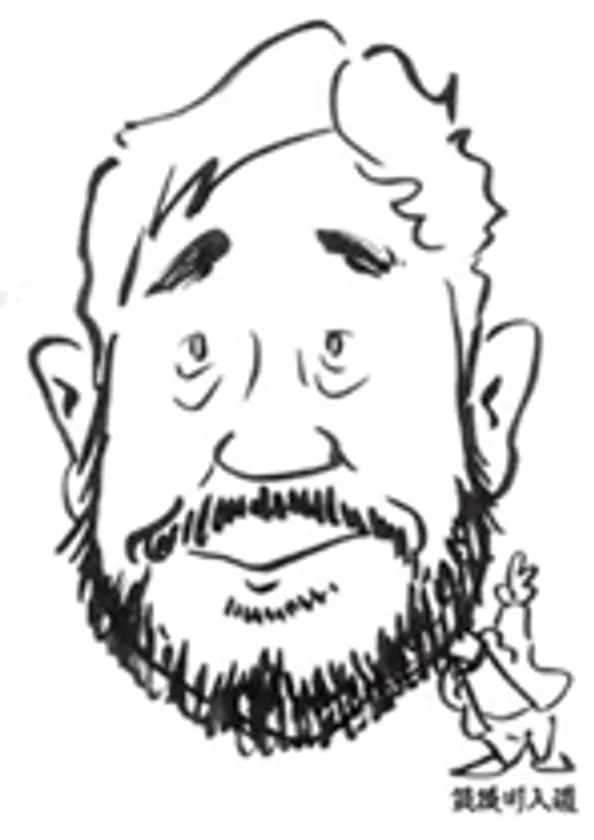
Image illustration of Dr. Dadai, aka Chikugo River Irido Kyusenbo
◎Comments from Dr. Wakabayashi
The realization of unique monetary value in a region is a mechanism to utilize the wealth of the region within the region. It is a system in which goods produced by people who live and work in the region are sold within the region and purchased by local people. K-money, which has a common monetary value in the region, will create, support, and develop this system. First of all, let's create a mechanism, even if it is a small one, that allows monetary values to function in the community and that makes the people who use it happy. Even if it is small, if it is realized, people in other regions will want to imitate it. Let's make them happy to imitate us. Then, like an amoeba, spread this system to all regions of Japan. The Chikugo River watershed is a good place to start. This is because it is a rich place with a strong primary industry. Kurume City, for example, has the highest agricultural output in Fukuoka Prefecture. They say, "Don't let good food travel. This is because traveling costs money, emits CO2, and reduces freshness. It is only in the Chikugo River basin, which is self-sufficient in delicious agricultural products, that local production for local consumption is possible and K-money can function.
Biography
Muneo Wakabayashi
Specially Appointed Professor at Graduate School of Project Design/Community Revitalization Evangelist, Cabinet Office.
Representative of Wakabayashi Business Support / Advisor to the General Incorporated Association of Management Practice and Research. Director of Furusato Sousei no Kai (Hometown Creation Association) / Director of Kyushu Food / Director of Kyushu Interpreters, Translators and Guides Association / Director of Fukuoka Design Action.
Former head of TV Tokyo's New York office (and correspondent) and the first news anchor of World Business Satellite.
◎Comments from Tatemi Hasebe
I have high expectations for "K-Money" as an important strategy for revitalizing the region, even for Oku-Hita, a region in the upper reaches of the river that is facing challenges in regional development. First of all, various activities for community development can be converted into points as a single value, and this will also lead to the creation of value, such as the discovery of historical culture and resources that lie in the area, as well as to the credibility and pride of the community. In addition, volunteer activities in times of disaster can be converted into points as a form of appreciation, which can also be used for mutual aid. In addition, since K-money can play an important role in the dissemination of information on regional tourism, it can further contribute to route-based tourism and inbound tourism by enabling each region to collaborate, share information, and work together as one. Since K-money, which is common to all regions, has a commitment to the region and a time limit for use, it can foster a conscious "love of the region" among users and, in turn, establish a regional community throughout the basin. And because they are digital regional points, data can be automatically collected and analyzed to visualize usage, which can be used for marketing purposes.
As such, it can be used as a tool for local governments, companies, stores, NPOs, etc. that wish to revitalize their areas and communities to work together, and as a method of pursuing economic ripple effects.
As such, it will play a very important role in the revitalization of the Chikugo River watershed. We are confident of its success.
Biography
Tateyoshi Hasebe
He is a planner and advisor for the (former) 6th industrialization planner and advisor of "Roadside Station Taio Kinzan" located on Route 442 in Hita City, Oita Prefecture. He is also a lecturer at Kurume University (Faculty of Economics) in the Watershed Course.
Taio Kinzan is the name of a gold mine that was reputed to be "the best gold mine in the Orient" at its peak around 1938, and is currently designated as a "Heritage of Industrial Modernization" by the Ministry of Economy, Trade and Industry. Some of the tunnels, which have been turned into an underground museum attached to the roadside station, and the surrounding area were the setting for Seicho Matsumoto's full-length novel "Saikaido Danki" (The Tale of Saikaido). Since the former Nakatsue Village attracted attention as the camp site of the Cameroon national team, the leading team at that time in the 2002 FIFA World Cup with Patrick Mboma and Samuel Eto'o, the exhibition facility still has memorabilia and materials of the players and others.
(*Former President and CEO of Tsue AP Corporation, a food processing company jointly established by the Tsue area of Hita City, Oita Prefecture (former Nakatsue, Kamitsue, and Maeatsue villages) and JA (two former agricultural cooperatives).
Comments from Hikaru Matsuo
For us in Daikichi Village, which is involved in self-sufficiency, food education, and parent-child experiential education together with fellow producers, we would like to use K-money in the sense of "kind money" or "pocket money". In Daikichi Village, there is no end to the amount of work we have to do in the fields throughout the year. It takes a lot of time and effort to grow healthy vegetables that are kind to the body. Although the actual work is simple and can be done by children, we would like to use "K-money" as a tool to exchange the value we provide with the children and think about the meaning of work with them through the work in the fields. In Daikichi Village, we have a "children's cafeteria" as an example of one way to solve the problem of social inequality in modern capitalism. We would like to use K-money in such a way that children whose families are poor and food insecure can come here to help out and receive "K-money". We believe that "K-money" is an important tool for Daikichi Village to help children learn the importance of work before they become delinquents.
Biography
Hikaru Matsuo
President and Village Mayor, Daikichi Village Co.
Daikichi Village was established in Arita Town, Saga Prefecture, which used to be a "pottery town" under the theme "Let's create the most fun village in Japan together. As a "model case of real happiness" in the new era of Japan, Daikichi Village is promoting its business with a challenger's spirit and "cheerful, fun, and energetic" spirit.
Instagram: https://www.instagram.com/hasamino.daikichi/
YouTube: https://www.youtube.com/channel/UCdLGpIusq64MWTFLcPQUGjA
Comments from Hideo Nishimoto
As the population continues to decline and the birthrate declines, and regional decline accelerates, how can we solve problems and implement lifestyle solutions utilizing the SDGs, DX, etc.? I believe that this will become a circle of wisdom that will drive the future of local communities. The role of "K-Money" is to connect "people, things, and goods" that have been carefully preserved in the Chikugo River basin, and to be a "trigger" that generates new cultural values and economic circulation. The operation of "K-money" itself, which promotes local production for local consumption and local contribution, will connect "road stations/river stations" scattered along the Chikugo River watershed with the local original monetary value of K-money, spread locally produced brands, add value to domestic and international tourism and stay in Japan, and like the flow of the river, will become a force for local development of the entire watershed. This is an unprecedented cyclical flow system. There is great potential to breathe life into such an unprecedented cyclical watershed economy. The idea of "K-Money" is to help realize the "enjoyable and sustainable society" and "mature society" brought about by the bounty of the Chikugo River watershed resources, as Professor Emeritus Dadai (Kurume University), the originator of this project, has been advocating for many years. We will promote this project so that "K-Money" will become a symbol to enhance the quality of life for men and women of all ages.
Biography
Hideo Nishimoto
President of Chikugogawa Biz Approach Media Satellite
Local Problem Solving Planner / Media Producer
Business corporation specializing in local development
Fukuho Media Agency, Chikugo River Business Co.
President and Representative Director
We will distribute news releases on the preparation/progress of the project in due course, but please contact Fukuho Media Agency, Inc. if you have any questions or concerns about the K Project or participation in related projects.
Company Profile
Fukuho Media Agency, Inc.
Address: 3-2-3-1407 Kashiteriha, Higashi-ku, Fukuoka-shi, Fukuoka 813-0017
Representative: Hideo Nishimoto, President
Tel: 092-692-7760
Direct line for public relations: 080-1456-4845
e-Mail : info@fma.agency
Distribution Company
This news release is distributed by Blue Alliance/AD Business Division on behalf of Fukuho Media Agency, Inc.
Blue Alliance Inc.
Head Office: Hamamatsucho Oak Building, 1-16-7 Hamamatsucho, Minato-ku, Tokyo 105-0013, Japan
Representative: Kazuya Kawano, Representative Director/CEO
- Category:
- Corporate Trends
